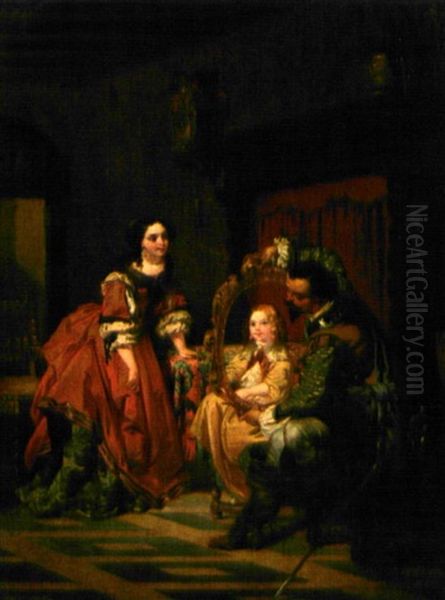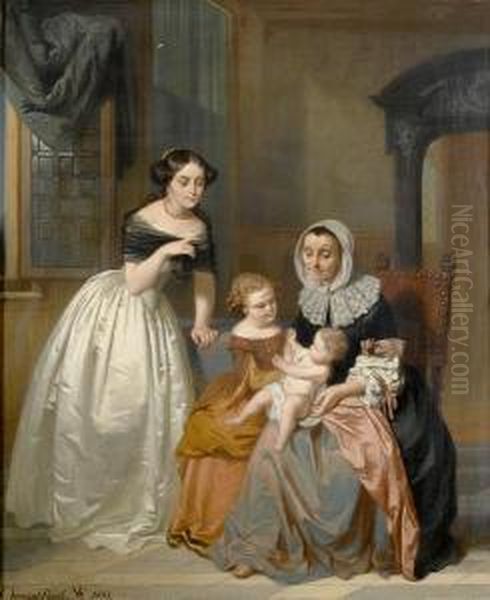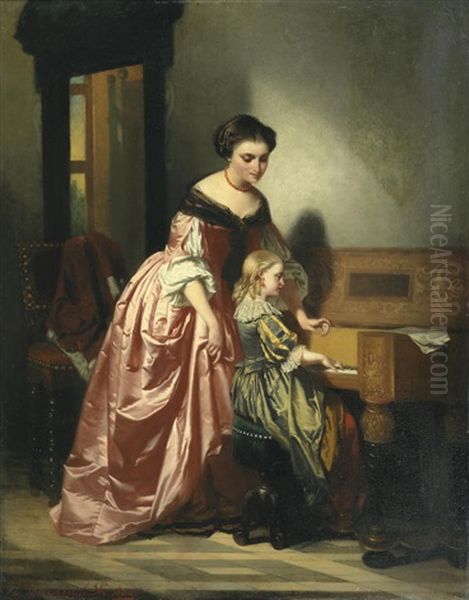Casimir Van den Daele (1818–1880) stands as a notable figure in 19th-century Belgian art, a period characterized by national self-discovery and a flourishing of Romantic and Realist traditions. While perhaps not as internationally renowned as some of his contemporaries, Van den Daele carved a distinct niche for himself with his charming and meticulously rendered genre scenes, historical vignettes, and intimate interiors. His work offers a valuable window into the social customs, aesthetic sensibilities, and everyday life of his time, executed with a sensitivity and technical skill that merits closer examination.
The Artistic Climate of 19th-Century Belgium
To fully appreciate Casimir Van den Daele's contribution, it is essential to understand the artistic environment in which he worked. Following Belgium's independence in 1830, there was a surge in national pride that found expression in the arts. Historical painting, often glorifying episodes from the nation's past, became particularly prominent. Artists like Gustave Wappers, Nicaise de Keyser, and Hendrik Leys were leading figures in this Belgian Romantic movement, producing large-scale canvases imbued with patriotic fervor and dramatic intensity.
Alongside this grand historical tradition, genre painting – the depiction of scenes from everyday life – also enjoyed immense popularity. This was partly an inheritance from the rich legacy of 17th-century Dutch and Flemish masters like Jan Steen or David Teniers the Younger, whose works were admired for their humor, detail, and observation of common folk. In the 19th century, genre painting often took on a sentimental or anecdotal quality, reflecting the bourgeois values and domestic ideals of the era. Van den Daele operated comfortably within this sphere, often infusing his scenes with a gentle Romanticism.
The period also saw the rise of Realism, championed by artists such as Gustave Courbet in France, which began to influence Belgian art towards the mid-century and beyond. While Van den Daele's work retains a strong Romantic and anecdotal flavor, the careful attention to detail in costume, setting, and human expression shows an observational acuity that aligns with the broader 19th-century interest in depicting the tangible world.
Early Life and Artistic Development

Specific details about Casimir Van den Daele's early life and formal artistic training are not extensively documented in widely accessible sources, a common fate for many competent artists who did not achieve the highest echelons of fame. He was born in 1818, placing his formative years squarely within the burgeoning Romantic era. It is highly probable that he received academic training, likely in one of Belgium's established art academies, such as those in Antwerp or Brussels, which were crucibles for artistic talent.
During this period, academic training would have emphasized drawing from casts and live models, the study of anatomy, perspective, and composition, and copying Old Masters. This rigorous grounding is evident in Van den Daele's skilled draughtsmanship and his ability to construct complex figural arrangements. His choice of subject matter – historical genre, domestic interiors, and scenes involving music and family – suggests an artist attuned to the prevailing tastes of the art market and the cultural preoccupations of his society.
His lifespan, 1818 to 1880, means he was a contemporary of major European artistic figures. In France, Eugène Delacroix and Jean-Auguste-Dominique Ingres were dominant forces in the first half of his life, while the Impressionist movement, with artists like Claude Monet and Edgar Degas, was gaining momentum towards the end of his career. In Britain, the Pre-Raphaelites, including Dante Gabriel Rossetti and John Everett Millais, were challenging academic conventions. Van den Daele, however, seems to have remained more closely aligned with the established traditions of Belgian Romanticism and genre painting.
Hallmarks of Van den Daele's Style
Casimir Van den Daele's paintings are characterized by several distinct features. His compositions are typically well-ordered and balanced, with figures placed naturally within carefully delineated interior or garden settings. He possessed a keen eye for detail, meticulously rendering fabrics, furniture, architectural elements, and accessories, which not only adds to the visual richness of his works but also provides valuable historical information about the material culture of the period.
His color palette is generally warm and harmonious, often employing rich browns, reds, and greens, contributing to the inviting and often cozy atmosphere of his scenes. The lighting in his paintings is usually soft and diffused, adeptly modeling figures and creating a sense of depth without harsh contrasts. This contributes to the overall gentle and somewhat idealized mood that pervades much of his work.

Figure painting was a clear strength. Van den Daele depicted individuals with a sensitivity that captured their character and emotional state, whether it be the concentration of a musician, the affection between family members, or the quiet dignity of a subject. His figures are often engaged in relatable activities – making music, reading, conversing, or interacting within a family group – which enhances the accessibility and appeal of his art.
Key Themes in His Oeuvre
Several recurring themes can be identified in Casimir Van den Daele's body of work, reflecting both his personal interests and the popular subjects of his time.
Domestic Harmony and Family Life
Many of Van den Daele's most charming works celebrate the virtues of family and the tranquility of domestic life. Paintings such as A Visit from Grandma (1853) and Famiglie nel giardino (Family in the Garden, 1853) exemplify this theme. These scenes often depict multi-generational family groups in comfortable, well-appointed interiors or serene garden settings. The interactions between figures are typically affectionate and harmonious, conveying a sense of warmth, stability, and bourgeois contentment.
In A Visit from Grandma, for instance, one can imagine a scene filled with tender interactions, the respect accorded to the elderly, and the innocent joy of children. Such paintings resonated with the 19th-century emphasis on the family as the cornerstone of society. Similarly, Le repos familial (Family at Rest, 1860) likely portrays a moment of shared leisure and quiet connection, reinforcing the ideal of the home as a sanctuary. These works can be seen in the tradition of Biedermeier art, prevalent in Germanic countries, which also focused on domesticity and middle-class life, as seen in the works of artists like Carl Spitzweg, though Van den Daele's style is distinctly Belgian Romantic.
The Allure of Music
Music-making is another prominent theme in Van den Daele's art. Two Women Making Music, created at some point during his active years (the broad date range 1818-1880 refers to his lifespan), and The Piano Lesson (1852, with another version possibly from 1853) highlight the importance of music as a social grace and a form of personal expression, particularly for women in the 19th century.

In Two Women Making Music, the artist likely captures the elegance and accomplishment of the performers. Such scenes often emphasized the refinement and cultural sophistication of the subjects. The Piano Lesson would have depicted a common aspect of a young lady's education, symbolizing discipline, cultural enrichment, and perhaps a moment of shared learning between teacher and student, or parent and child. The depiction of musical instruments, sheet music, and the focused expressions of the musicians would have been rendered with his characteristic attention to detail. This theme was popular across Europe, with artists like James Tissot in France and Britain also depicting elegant musical soirées.
Historical Narratives and Costumed Scenes
Van den Daele also ventured into historical genre, creating scenes that, while not always depicting specific major historical events, evoked the atmosphere and costume of earlier periods. A Lady and Her Doctor (1857) and an untitled painting described as depicting a knight (1857) fall into this category. These works allowed for the depiction of more elaborate costumes and settings, appealing to the Romantic fascination with the past.
A Lady and Her Doctor might explore themes of vulnerability, care, and the social dynamics of a medical consultation in a bygone era. The knightly scene would tap into the chivalric ideals often romanticized in the 19th century. Such paintings share thematic similarities with the work of French artists like Jean-Louis-Ernest Meissonier, who was renowned for his incredibly detailed small-scale historical genre scenes, or Belgian contemporaries like Florent Willems, who also specialized in costumed genre pieces.
The Artist's World
The painting titled Intérieur romantique chez le peintre (Romantic Interior in the Painter's Studio, 1857) offers a fascinating glimpse into the artist's own milieu, or at least an idealized version of it. Such scenes were popular as they provided insight into the creative process and the environment of the artist, often romanticizing the artist's life and status. This work likely depicted a studio filled with art objects, props, perhaps a model, and the tools of the trade, all bathed in the characteristic soft light of a Romantic interior. It speaks to a self-awareness of the artist's role and the aesthetic of the Romantic movement itself.
Notable Works: A Closer Look
While a comprehensive catalogue raisonné might be elusive, several works consistently attributed to Van den Daele provide a good representation of his talent.
A Visit from Grandma (1853): This painting is emblematic of his focus on familial bonds. One can envision a composition centered around the grandmother figure, perhaps seated comfortably, surrounded by her children and grandchildren. The details of their attire, the furnishings of the room, and the expressions of affection and respect would be key elements. The painting likely conveys a sense of warmth, tradition, and the continuity of family life, appealing to the sentimental values of the Victorian era.
The Piano Lesson (1852/1853): This subject was a staple of 19th-century genre painting. Van den Daele's interpretation would likely focus on the intimate setting of a drawing-room, with a young student at the piano, perhaps guided by an older teacher or family member. The scene would emphasize concentration, the elegance of the figures, and the cultural importance of musical education. The careful rendering of the piano itself, the sheet music, and the fashionable attire of the figures would showcase his skill in depicting textures and details.
Famiglie nel giardino (1853): Translating to "Family in the Garden," this work suggests an outdoor scene of domestic leisure. Gardens in the 19th century were often seen as extensions of the home, places for relaxation, play, and polite social interaction. Van den Daele would likely depict a well-dressed family group enjoying a pleasant day, perhaps with children playing, adults conversing, or engaged in quiet pastimes like reading or needlework. The interplay of figures with the natural setting would offer opportunities for charming compositions and the depiction of sunlight filtering through foliage.
Intérieur romantique chez le peintre (1857): This painting is particularly intriguing as it potentially offers a self-referential look at the artist's environment. A "Romantic interior" suggests a space curated with an eye for aesthetic appeal, perhaps slightly cluttered with inspiring objects, tapestries, sculptures, and paintings. The artist himself might be depicted at his easel, or the focus could be on a model or a general atmosphere of creative endeavor. It reflects the 19th-century cult of the artist and the romanticization of the studio as a haven of creativity.
Van den Daele in Context: Contemporaries and Influences
Casimir Van den Daele worked during a vibrant period for Belgian art. He was a contemporary of Hendrik Leys (1815-1869), a major figure in Belgian historical Romanticism, whose influence was profound. While Leys often tackled grander historical themes, his attention to detail and evocative portrayal of past eras may have resonated with Van den Daele. Alfred Stevens (1823-1906), though Belgian, achieved great fame in Paris for his elegant depictions of fashionable women in luxurious interiors; while Stevens's subjects were more modern and cosmopolitan, the shared interest in detailed interior scenes and refined figures provides a point of comparison.
Henri de Braekeleer (1840-1888), a later contemporary, also excelled in intimate interior scenes, though his style evolved towards a more introspective and psychologically nuanced Realism. The works of earlier Flemish and Dutch masters, such as Pieter de Hooch or Johannes Vermeer, with their tranquil domestic scenes and masterful handling of light, undoubtedly formed part of the artistic heritage that informed genre painters like Van den Daele.
Internationally, the meticulous historical genre scenes of French artists like Jean-Léon Gérôme or the aforementioned Meissonier were immensely popular and set a standard for detailed realism in historical costume pieces. In Britain, artists like William Powell Frith captured sprawling scenes of Victorian life, sharing Van den Daele's interest in chronicling contemporary society, albeit often on a grander scale.
Artistic Legacy and Reception
Casimir Van den Daele may not have been an avant-garde innovator who radically altered the course of art history, but he was a highly skilled and sensitive painter who excelled within his chosen genres. His works were well-suited to the tastes of the 19th-century bourgeoisie, who appreciated art that was relatable, sentimental, and aesthetically pleasing. His paintings would have found homes in private collections, adorning the walls of comfortable middle-class residences.
Today, his works appear periodically at auctions, and while they may not command the prices of the era's biggest names, they are appreciated for their charm, historical value, and artistic merit. For art historians and enthusiasts interested in 19th-century Belgian art and the broader traditions of Romantic genre painting, Van den Daele's oeuvre provides valuable insights. His depictions of domestic life, musical pursuits, and historical settings contribute to our understanding of the cultural fabric of his time.
There is no record of Van den Daele being involved in major artistic controversies or being a central figure in any specific, named artistic group beyond the general tendencies of Belgian Romanticism and genre painting. He appears to have been a dedicated artist who consistently produced quality work, contributing to the rich tapestry of 19th-century European art. His paintings serve as quiet but eloquent testimonies to the everyday lives, aspirations, and aesthetic preferences of a bygone era.
Conclusion: A Master of Intimate Narratives
Casimir Van den Daele was a quintessential artist of his time, adeptly capturing the spirit of 19th-century Belgian society through his detailed and engaging paintings. His focus on family, music, history, and the artist's own world, rendered with technical proficiency and a gentle Romantic sensibility, ensures his place as a significant, if perhaps under-sung, contributor to the genre painting tradition. His works invite viewers to step into the parlors, gardens, and studios of the past, offering moments of quiet reflection and an appreciation for the enduring themes of human connection and cultural expression. In a world often dominated by grand narratives, Van den Daele's art reminds us of the beauty and significance to be found in the more intimate chronicles of life. His legacy is that of a careful observer and a skilled storyteller in paint, a Belgian master whose canvases continue to charm and inform.